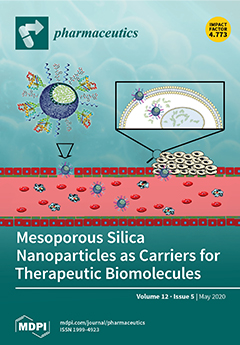Behavioural and psychological symptoms of dementia (BPSD), including fear-anxiety- and depressive-like behaviour, are present in Alzheimer’s disease (AD), together with memory decline. I
2-imidazoline receptors (I
2-IRs) have been associated with neuropsychiatric and neurodegenerative disorders, further, I
2-IR ligands have
[...] Read more.
Behavioural and psychological symptoms of dementia (BPSD), including fear-anxiety- and depressive-like behaviour, are present in Alzheimer’s disease (AD), together with memory decline. I
2-imidazoline receptors (I
2-IRs) have been associated with neuropsychiatric and neurodegenerative disorders, further, I
2-IR ligands have demonstrated a neuroprotective role in the central nervous system (CNS). In this study, we assessed the effect of the I
2-IR ligand MCR5 on both cognitive and non-cognitive symptoms in the Senescence accelerated mice prone 8 (SAMP8) mouse model. Oral administration of I
2-IR ligand MCR5 (5 mg/kg/day for four weeks) in 10-month SAMP8 mice ameliorated both BPSD-like phenotype and cognitive decline by attenuating depressive-like behaviour, reducing fear-anxiety-like behaviour and improving cognitive performance using different tasks. Interaction of I
2-IR ligand MCR5 with serotoninergic system did not account for behavioural or cognitive improvement, although changes in molecular pathways underlying depression and anxiety phenotype were observed. MCR5 increased levels of p-AKT, phosphorylated glycogen synthase kinase 3 β (GSK3β) at Ser9 and phosphorylated mammalian target of rapamycin complex 1 (mTORC1) levels in SAMP8 treated mice compared to SAMP8 control. Moreover, MCR5 treatment altered N-methyl-d-aspartate receptor (NMDA) 2B phosphorylation, and decreased the protein levels of phosphorylated cyclin-dependent kinase 5 (p-CDK5) and dopamine- and cyclic adenosine monophosphate (cAMP)-regulated phosphoprotein of Mr 32 kDa phosphorylated at Thr75 (p-DARPP32), with a parallel increase in protein kinase A (PKA) and p-cAMP response element-binding (pCREB) levels. Consistent with these changes MCR5 attenuated neuroinflammation by decreasing expression of pro-inflammatory markers such as
Tumor necrosis factor-alpha (Tnf-α), Interleukin 1β (Il-1β), Interleukin 6 (Il-6), and promoted synaptic plasticity by increasing levels of postsynaptic density protein 95 (PSD95) as well as ameliorating tropomyosin-related kinase B (TrkB) and nerve growth factor receptor (NGFR) signalling. Collectively, these results increase the potential of highly selective I
2-IR ligands as therapeutic agents in age-related BPSD and cognitive alterations.
Full article






